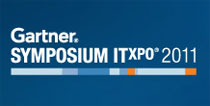Enterprise IT Spending to Reach $2.7 Trillion in 2012. Now Is the Time to Re-Imagine the Role of IT, Says Gartner.
According to recent information coming from Gartner, global enterprise IT spending is projected to total $2.7 trillion in 2012. That figure represents a 3.9 percent increase from 2011 spending of $2.6 trillion. Despite increased IT spending during in a tough economic climate, growth is slowing from the expected 5.9 percent increase in 2011.

On Monday, Peter Sondergaard, senior vice president at Gartner and global head of Research, provided an outlook for the IT industry to an audience of CIOs and IT leaders at the Gartner Symposium/ITxpo, taking place in Orlando this week.
“The days when IT was the passive observer of the world are over. Global politics and the global economy are being shaped by IT,” Sondergaard said. “IT is a primary driver of business growth. For example, this year 350 companies will each invest more than $1 billion in IT. They are doing this because IT impacts their business performance.”
Sondergaard said that two-thirds of CEOs believe IT will make a greater contribution to their industry in the next 10 years than any prior decades.
“For the IT leader to thrive in this environment, IT leaders must lead from the front and re-imagine IT,” Sondergaard said. “IT leaders must embrace the post-modern business, a business driven by customer relationships, fueled by the explosion in information, collaboration, and mobility.”
Gartner believes that this new era brings with it urgent and compelling forces, including: the cloud, social, mobility, and an explosion in information.
The Cloud
Gartner estimates that while $74 billion was spent on public cloud services in 2010, that only represented 3 percent of enterprise spending. But, public cloud services will grow five times faster than overall IT enterprise spending (19 percent annually through 2015).
“What supply chain models did to manufacturing is what cloud computing is doing to in-house data centers. It is allowing people to optimize around where they have differentiated capabilities,” Mr. Sondergaard said.
Social
The next stage of social computing is about mass-customer, mass-citizen, and mass-employee involvement with enterprise systems.
“With 1.2 billion people on social networks, 20 percent of the world’s population, social computing is in its next phase,” Sondergaard said. “IT leaders must immediately incorporate social software capabilities throughout their enterprise systems.”
Information
The concept of one enterprise data warehouse containing all information needed for decisions is dead. Multiple systems, including content management, data warehouses, data marts and specialized file systems tied together with data services and metadata, will become the “logical” enterprise data warehouse.
Mobile
The shift to mobile is almost overtaking many IT organizations who can’t move fast enough to catch up. Mobile is not a coming trend. It has already happened. In 2010, the installed base of mobile PCs and smartphones exceeded that of desktop PCs.
Less than 20 million media tablets, such as the iPad, were sold in 2010, but by 2016, 900 million media tablets will be purchased – one for every eight people on earth. By 2014, the installed base of devices based on lightweight mobile operating systems, such as Apple’s iOS, Google’s Android, and Microsoft’s Windows 8 will exceed the total installed base of all PC-based systems.
“That’s incredible change, not only for individuals. It requires IT to re-imagine the way it provides applications,” said Sondergaard. “By 2014, private app stores will be deployed by 60 percent of IT organizations. The applications themselves will be redesigned – they will become context-enabled, understanding the user’s intent automatically. Mobile computing is not just the desktop on a handheld device. The future of mobile computing is context-aware computing.”
“The impact of these forces will make architectures of the last 20 years obsolete,” Sondergaard concluded. “Together, they force the issue – they drive us to create the post-modern business, drive simplicity and force creative destruction.”












